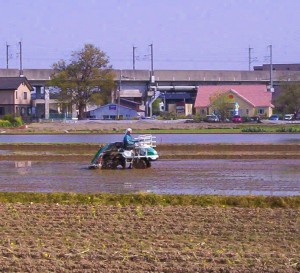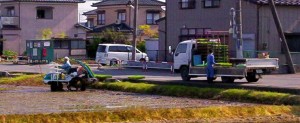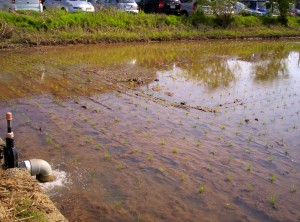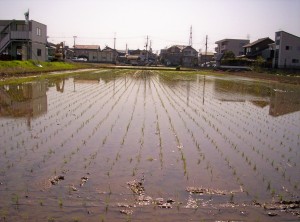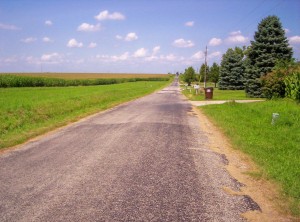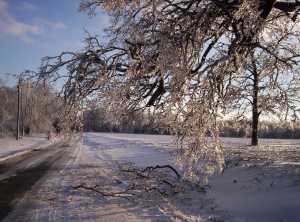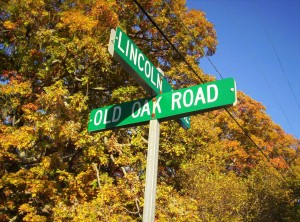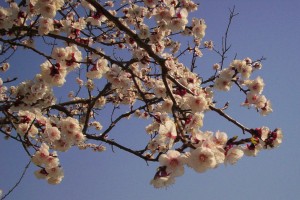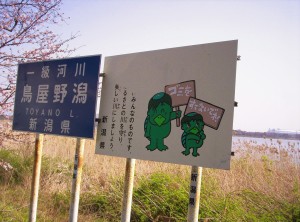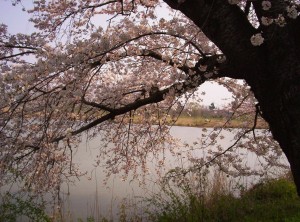I’ve been thinking about trees. That’s probably because they figure largely into the story I’m working on now. The more I reflect, the more I become convinced that trees may well be our single most significant (natural) connection to the numinous. I say “natural,” because our other connection is books–or, more accurately, stories–which is a link we humans have made. But trees are there all around us, shading us and whispering to us, breathing out oxygen to make our air sweeter, and beautifying our landscape . . . and perhaps their gifts to us only begin there. Walk with me, if you will, as I expound my theory.
I’m going to quote from Hope Mirrlees in Lud-in-the-Mist. She’s talking about a “pleached alley” here, which is a path between two rows of trees, with the trees all intertwined and roofing the road over, so that you have a shady tunnel. Here’s the quote:
“There was also a pleached alley of hornbeams.
“To the imaginative, it is always something of an adventure to walk down a pleached alley. You enter boldly enough, but soon you find yourself wishing you had stayed outside — it is not air that you are breathing, but silence, the almost palpable silence of trees. And is the only exit that small round hole in the distance? Why, you will never be able to squeeze through that! You must turn back . . . too late! The spacious portal by which you entered has in its turn shrunk to a small round hole.”
To pass into the trees is to enter the realm of magic, mystery, and things beyond us. Is it any wonder that trees are so prominently placed in the cosmologies of so many peoples throughout history? Norse mythology tells of Yggdrasil, the World Tree, which supports and is itself the pathway among all the realms of gods, giants, monsters, and men. The Ragnarok, the end of the Universe, happens when Yggdrasil is eaten through by its enemies and comes crashing down.
Judaism and Christianity look back to Eden: the one time when the world was perfect was when the first man and woman lived in a Garden, and at the Garden’s very center were two trees. Trees sustained the lives of Adam and Eve by providing fruit for their food.
For a cultural anthropology class in college, we read a book about the Grand Valley Dani of New Guinea. A belief of the Dani people that I’ve never forgotten is that the human race was made from trees that were brought to life — trees given animation, eyes, and hands.
It’s often said by Christian scholars that all peoples throughout history have arrived at parts of the Truth; if you live in this world and look around and think, it’s nearly impossible to avoid figuring out some of it, even without divine revelation. And one thing that almost everyone “gets” is that trees are extremely sacred.
Then I began to think about trees and fantasy fiction . . . particularly, how trees relate to the writings of J.R.R. Tolkien. There’s so much to be explored there that I wondered this evening if any scholarly research has been done on the subject. Seriously — someone should write a thesis or dissertation on Tolkien’s Trees. [Nicholas? Has it been done?]
In one real sense, I believe it was trees that drew me first to read Tolkien’s books. I remember illustrations in fairy tale books from when I was very young — enchanting pictures of the deep, dark forests in which various protagonists were either lost or out cutting wood. And when I saw the Ballantine editions of The Hobbit and The Lord of the Rings — those marvelous paperbacks whose covers bore illustrations by Tolkien himself — I knew I had to read them. It was the very same stuff from those childhood pictures that had captured my imagination. The Hobbit‘s cover was Bilbo riding his barrel down the River Running, gliding beneath those gorgeous, fantastic trees. The Two Towers had that picture which is probably my favorite of all Tolkien’s artwork, because it’s all trees, nothing but trees! Yes, it has two tiny figures down in the corner . . . figures who are, depending on which of Tolkien’s notes you believe, either Merry and Pippin in Fangorn Forest or Beleg and Gwindor in Taur-na-Fuin. (Tolkien adamantly resisted drawing clear or up-close pictures of his characters, because he wanted to leave them to the reader’s imagination: but he had no compunction about drawing his trees in every loving detail!)
So, then: Tolkien’s books, I say, are a journey from tree to tree to tree! That’s what drew me in, because I already knew as a child that trees were the real things: trees were the door-posts of Faerie. My favorite part in The Hobbit is the journey through Mirkwood. There are times even now when I think about Mirkwood and can still get that shivery, watery sense of delight in my lower chest that we feel all the time as kids but so rarely do in later years. You know the feeling I mean, right? Mirkwood and Fangorn and the Old Forest can still do that for me.
The Lord of the Rings — what is more beautiful and tree-filled than the descriptions of Lothlorien? But let’s go deeper still: the story begins and ends with a tree. Right? Bilbo’s eleventy-first birthday party takes place beneath the Party Tree, the symbol of all that is good and wholesome and stolid and warm and homey and peaceful and comfortable about the Shire. And at the end of the book, the terrible cutting down of that Party Tree is the last straw: that’s the signal that the world is irrevocably changed, that the wounds sustained in this vale of tears will not be healed on this side. It’s the sight of that tree cut down that brings Sam to tears.
The Silmarillion, with its Two Trees of Valinor: like Eden, that was the one time when the world was perfect and right, when those Two Trees gave their mingled light. It’s their light, mind you — the light of trees — that’s in the silmarils.
Back to LOTR: Gondor has its White Tree. When it withers, the realm is in deepest trouble.
What shows us that Mordor is the land of evil? What’s the one thing that Mordor has none of? Yup. No trees.
What does Saruman do when he goes bad? He takes down the trees. Then the trees take him down, when Birnham Wood comes to Dunsinane, or . . . something like that.
And that brings us to the Ents. The Ents are “Earth-born, old as mountains,” second in antiquity only to the Elves. Treebeard refers to “young Master Gandalf” and “young Saruman down at Isengard.” [I love how Celeborn addresses Fangorn as “Eldest.” Man, that gives me goosebumps!] Ents are the shepherds of trees — tree-herders. Think of the implications of that. The function of these ancient sentient creatures in Tolkien’s world is to look out for the trees. It’s as if Tolkien meant the Ents to be representatives of the Earth itself.
My favorite Dr. Seuss book is The Lorax (and not just because of the Onceler). It’s for all sorts of reasons that tug at the dreamer’s heart: the fact that there’s a crumbling platform out at the end of town, overgrown by grass, which is all that remains to show where the Lorax stood, and from where he was “taken away” (by lifting himself into the sky by the seat of his pants) . . . but most of all, the fact that the Lorax “speak[s] for the trees.”
So, then, here are some of my tree memories:
I grew up on Old Oak Road, right, named for its abundance of ancient oak trees? I think I’ve told this story on this blog before, but near as we can figure from a perusal of very old maps, Abraham Lincoln himself may well have passed within sight of where my house now stands, as he rode along on his 8th Judicial Circuit route from Allenton (now vanished) to the up-and-coming little hamlet of Taylorville. And if he did, then it’s likely he looked right at the two trees that shaded my front yard when I was a kid. They would have been younger in Lincoln’s day, but they would have been there: oaks live a long time and grow slowly. Perhaps the lanky young lawyer even rested beneath one and drank from his bottle of Gatorade.
What impressed me about those oaks as a kid was how they harbored a whole other world up in their crowns, 20, 30, 40 feet above the ground — a world of limbs and leaves that I could glimpse from afar, but could never reach. (Isn’t it that precise longing for the misty realm on the horizon that has always fueled our romances? Avalon . . . Lyonesse . . . Mu . . . Lemuria . . . Shangri-La . . . Atlantis. . . .) The world was always there, always visible at the top of my tire swing’s chain. I climbed up that chain more than once — all the way up, scraping my bare feet, painting them orange with rust — I climbed up and clung for a moment to the earth-most giant limb of that world of squirrels and birds. But even I had the sense to go no farther, for it would likely have been the death of me.
There was a hole at the base of that oak tree, one of those little caves that often form in old trees. I imagined wee folk who lived inside the trunk in many-storied mansions. I used to go out with a lantern and look for them on Midsummer’s Eve. (You think I’m kidding, but I’m not.)
There was a willow tree in our north yard that my nextdoor neighbor and I used to climb. It had a friendly array of branches that were like a basket for holding little kids who wanted to play above the yard. That tree was like a Phoenix: its trunk snapped completely off at ground level during an ice storm, and my parents thought that was the end of it. But the whole tree grew again from the stump.
I had a reading grove in the northwest corner of the front yard. I’d sit in a lawn chair and put my feet in the fork of a young oak tree that is not so young now. I remember writing a lot of The Threshold of Twilight there and reading a lot of Stephen R. Donaldson. My good dog Hooper is also buried in that grove.
I remember gazing always at that great wall of oaks to the south of our property (see the aerial photo in the previous posting). It was a mighty, rolling green cliff, full of twilight caverns signifying mystery. That, to me as a boy, was the rampart of Mirkwood.
To the south of our place along the road there was a gigantic oak that I always called the Silhouette Tree. Apparently “silhouette” was a word I learned early on and especially loved, and I’d point to that tree at sunset and use the word. (That tree has just been cut down in the past year–I noticed it gone the last time I was there.)
In the middle of the field between my neighbor’s house and mine was another old, gigantic tree. We used to play there, building secret little clubhouses around its base. It was especially nice when the field was in corn, and we had to pass through the whispering stalks to get there, its towering height guiding us as a landmark as we navigated toward it, and the field shutting out all the world. My dad always cautioned us to be careful, that a lone tree in a field could indicate the site of a long-vanished homestead, and thus that there might be an abandoned well somewhere in its shadow, perhaps covered by a now-rotted layer of boards. (My dad was among the greatest worriers in human history.) That always added to the charm for us, that at any moment the ground might collapse beneath our feet. We used to prod and search and hope for that long-lost well, but with no success.
Mom had a grape arbor, and the vines quested out and climbed a maple tree at the back corner of the tin shed. In the arbor’s heyday, the tree itself was full of grapes. It was a grape tree. My nextdoor neighbor and I used to sit up there, high above the world, and eat them.
And here’s a story for you: at my grandma’s house in town, there was a birch tree. During a storm, the trunk shattered, and the tree was left leaning over the street and sidewalk. The trunk was completely severed, so it had to be cut down. Grandma enlisted me and all the neighborhood kids to do the job. That will forever remain as a “photograph of the heart”: there we all were, a scruffy, barefoot kid on just about every limb, each equipped with a saw, a hatchet, or a pair of clippers. Many of us were vigorously sawing through the limbs between ourselves and the bole. Every so often a kid would plummet earthward with a shriek. And down on the ground, there was the biggest boy in the neighorhood, methodically sawing through the trunk with the biggest saw. We all lived, and none of us were hurt.
So, dear readers — tell us your tree stories! Did you have a treehouse? Did you climb trees, maybe with a book in your pocket? Did you have a secret clubhouse sheltered by tree branches? If so, take us all there, so that those worlds may live again!


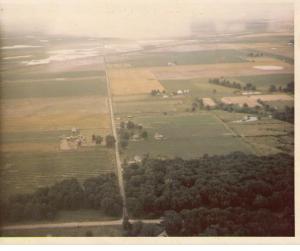
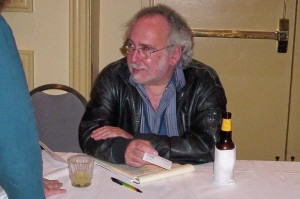




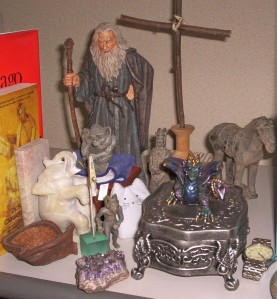 A week or two ago, a faithful reader requested reading lists. It’s a bottomless well, an insurmountable task, but let’s go there. We have to understand from the outset that there’s no way we’ll get everything essential onto the lists. But I think we can make helpful lists of some of the very best books out there. I think I’ve talked enough for this time around: I’m going to save my own picks for next time. But feel free to start jumping in: give us a list of any reasonable length — 3, 5, a dozen, 20 books — the books that belong on the small shelf; the best books you’ve discovered in your lifetime, be it short or long. Yes, this blog lies in the native country of fantasy, but you’re not required to limit yourself to that genre. You don’t have to worry about ranking them in order (unless you want to), and I think we all agree that The Lord of the Rings and Watership Down are there already.
A week or two ago, a faithful reader requested reading lists. It’s a bottomless well, an insurmountable task, but let’s go there. We have to understand from the outset that there’s no way we’ll get everything essential onto the lists. But I think we can make helpful lists of some of the very best books out there. I think I’ve talked enough for this time around: I’m going to save my own picks for next time. But feel free to start jumping in: give us a list of any reasonable length — 3, 5, a dozen, 20 books — the books that belong on the small shelf; the best books you’ve discovered in your lifetime, be it short or long. Yes, this blog lies in the native country of fantasy, but you’re not required to limit yourself to that genre. You don’t have to worry about ranking them in order (unless you want to), and I think we all agree that The Lord of the Rings and Watership Down are there already.
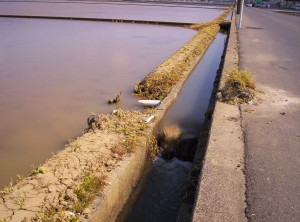

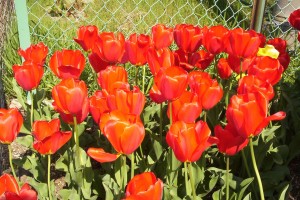







 “The Enchanted Mountain: A Tale of Long-Ago Japan”:
“The Enchanted Mountain: A Tale of Long-Ago Japan”:
 “Uther”:
“Uther”:

